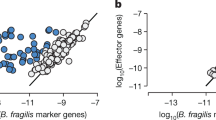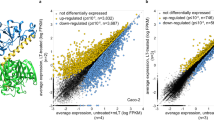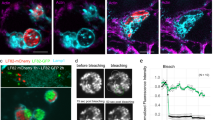Abstract
Bacterial toxins are well-studied virulence factors; however, recent studies have revealed their importance in bacterial niche adaptation. Enterotoxigenic Bacteroides fragilis (ETBF) expresses B. fragilis toxin (BFT) that we hypothesized may contribute to both colonic epithelial injury and niche acquisition. We developed a vertical transmission model for ETBF in mice that showed that BFT enabled ETBF to access a lamina propria (LP) niche during colonic microbiome development that was inaccessible to non-toxigenic B. fragilis. LP entry by ETBF required BFT metalloprotease activity, and showed temporal restriction to the pre-weaning period, dependent on goblet-cell-associated passages. In situ single-cell analysis showed bft expression at the apical epithelial surface and within the LP. BFT expression increased goblet cell number and goblet-cell-associated passage formation. These findings define a paradigm by which bacterial toxin expression specifies developmental niche acquisition, suggesting that a selective advantage conferred by a toxin may impact long-term host health.
This is a preview of subscription content, access via your institution
Access options
Access Nature and 54 other Nature Portfolio journals
Get Nature+, our best-value online-access subscription
$29.99 / 30 days
cancel any time
Subscribe to this journal
Receive 12 digital issues and online access to articles
$119.00 per year
only $9.92 per issue
Buy this article
- Purchase on Springer Link
- Instant access to full article PDF
Prices may be subject to local taxes which are calculated during checkout






Similar content being viewed by others
Data availability
All data supporting the findings of this study are available within the paper and its Supplementary Information. Raw images supporting each relevant figure are available at https://www.ebi.ac.uk/bioimage-archive/ via BioStudies accession number S-BIAD922. Source data are provided with this paper.
Code availability
No specific code was used in the analysis of data in this article.
References
Nagpal, R. et al. Sensitive quantitative analysis of the meconium bacterial microbiota in healthy term infants born vaginally or by cesarean section. Front. Microbiol. 7, 1997 (2016).
Valles-Colomer, M. et al. The person-to-person transmission landscape of the gut and oral microbiomes. Nature 614, 125–135 (2023).
Lee, S. M. et al. Bacterial colonization factors control specificity and stability of the gut microbiota. Nature 501, 426–429 (2013).
Zitomersky, N. L., Coyne, M. J. & Comstock, L. E. Longitudinal analysis of the prevalence, maintenance, and IgA response to species of the order Bacteroidales in the human gut. Infect. Immun. 79, 2012–2020 (2011).
Zhao, S. et al. Adaptive evolution within gut microbiomes of healthy people. Cell Host Microbe 25, 656–667.e658 (2019).
Verster, A. J. et al. The landscape of type VI secretion across human gut microbiomes reveals its role in community composition. Cell Host Microbe 22, 411–419.e414 (2017).
Sears, C. L., Geis, A. L. & Housseau, F. Bacteroides fragilis subverts mucosal biology: from symbiont to colon carcinogenesis. J. Clin. Investig. 124, 4166 (2014).
Rhee, K. J. et al. Induction of persistent colitis by a human commensal, enterotoxigenic Bacteroides fragilis, in wild-type C57BL/6 mice. Infect. Immun. 77, 1708–1718 (2009).
Dejea, C. M. et al. Patients with familial adenomatous polyposis harbor colonic biofilms containing tumorigenic bacteria. Science 359, 592–597 (2018).
Chan, J. L. et al. Non-toxigenic Bacteroides fragilis (NTBF) administration reduces bacteria-driven chronic colitis and tumor development independent of polysaccharide A. Mucosal Immunol. 12, 164–177 (2019).
Hecht, A. L. et al. Strain competition restricts colonization of an enteric pathogen and prevents colitis. EMBO Rep. 17, 1281–1291 (2016).
Yatsunenko, T. et al. Human gut microbiome viewed across age and geography. Nature 486, 222–227 (2012).
Faith, J. J. et al. The long-term stability of the human gut microbiota. Science 341, 1237439 (2013).
Zmora, N. et al. Personalized gut mucosal colonization resistance to empiric probiotics is associated with unique host and microbiome features. Cell 174, 1388–1405.e1321 (2018).
Donaldson, G. P. et al. Spatially distinct physiology of Bacteroides fragilis within the proximal colon of gnotobiotic mice. Nat. Microbiol 5, 746–756 (2020).
Russell, A. B. et al. A type VI secretion-related pathway in Bacteroidetes mediates interbacterial antagonism. Cell Host Microbe 16, 227–236 (2014).
Chatzidaki-Livanis, M., Geva-Zatorsky, N., Comstock, L. E. & Hooper, L. V. Bacteroides fragilis type VI secretion systems use novel effector and immunity proteins to antagonize human gut Bacteroidales species. Proc. Natl Acad. Sci. USA 113, 3627–3632 (2016).
Rivera-Chávez, F. & Mekalanos, J. J. Cholera toxin promotes pathogen acquisition of host-derived nutrients. Nature 572, 244–248 (2019).
Pruss, K. M. & Sonnenburg, J. L. C. difficile exploits a host metabolite produced during toxin-mediated disease. Nature 593, 261–265 (2021).
Fletcher, J. R. et al. Clostridioides difficile exploits toxin-mediated inflammation to alter the host nutritional landscape and exclude competitors from the gut microbiota. Nat. Commun. 12, 462 (2021).
Wu, S. et al. A human colonic commensal promotes colon tumorigenesis via activation of T helper type 17 T cell responses. Nat. Med. 15, 1016–1022 (2009).
Chambers, F. G. et al. Bacteroides fragilis toxin exhibits polar activity on monolayers of human intestinal epithelial cells (T84 cells) in vitro. Infect. Immun. 65, 3561–3570 (1997).
Knoop, K. A., McDonald, K. G., Kulkarni, D. H. & Newberry, R. D. Antibiotics promote inflammation through the translocation of native commensal colonic bacteria. Gut 65, 1100–1109 (2016).
Wexler, A. G. et al. Human symbionts inject and neutralize antibacterial toxins to persist in the gut. Proc. Natl Acad. Sci. USA 113, 3639–3644 (2016).
Steele, M. I., Kwong, W. K., Whiteley, M. & Moran, N. A. Diversification of type VI secretion system toxins reveals ancient antagonism among bee gut microbes. mBio 8, e01630–17 (2017).
Speare, L. et al. Bacterial symbionts use a type VI secretion system to eliminate competitors in their natural host. Proc. Natl Acad. Sci. USA 115, E8528–E8537 (2018).
Knoop, K. A. et al. Microbial antigen encounter during a preweaning interval is critical for tolerance to gut bacteria. Sci. Immunol. 2, eaao1314 (2017).
Kim, M., Fevre, C., Lavina, M., Disson, O. & Lecuit, M. Live imaging reveals listeria hijacking of E-cadherin recycling as it crosses the intestinal barrier. Curr. Biol. 31, 1037–1047.e1034 (2021).
Choi, V. M. et al. Activation of Bacteroides fragilis toxin by a novel bacterial protease contributes to anaerobic sepsis in mice. Nat. Med. 22, 563–567 (2016).
Hecht, A. L., Casterline, B. W., Choi, V. M. & Bubeck Wardenburg, J. A two-component system Regulates Bacteroides fragilis toxin to maintain intestinal homeostasis and prevent lethal disease. Cell Host Microbe 22, 443–448.e445 (2017).
Taylor, S. J. & Winter, S. E. Salmonella finds a way: metabolic versatility of Salmonella enterica serovar Typhimurium in diverse host environments. PLoS Pathog. 16, e1008540 (2020).
Casterline, B. W., Hecht, A. L., Choi, V. M. & Bubeck Wardenburg, J. The Bacteroides fragilis pathogenicity island links virulence and strain competition. Gut Microbes 8, 374–383 (2017).
Goulas, T., Arolas, J. L. & Gomis-Rüth, F. X. Structure, function and latency regulation of a bacterial enterotoxin potentially derived from a mammalian adamalysin/ADAM xenolog. Proc. Natl Acad. Sci. USA 108, 1856–1861 (2011).
Whitaker, W. R., Shepherd, E. S. & Sonnenburg, J. L. Tunable expression tools enable single-cell strain distinction in the gut microbiome. Cell 169, 538–546 e512 (2017).
Sage, D. et al. DeconvolutionLab2: an open-source software for deconvolution microscopy. Methods 115, 28–41 (2017).
Acknowledgements
This work was supported by a Pilot and Feasibility Award from the Digestive Diseases Research Core Center at the University of Chicago (NIDDK P30DK42086), National Institutes of Health (NIH) Award DK085025 to J.L.S., and NIH Awards AI138565 and AI157196 to J.B.W. B.W.C. was supported by the National Institute of Allergy and Infectious Diseases of the NIH (F30AI126791). B.W.C. and A.L.H. were trainees of the NIH Medical Scientist Training Program at the University of Chicago (GM007281). Math1fl/fl Vil-Cre-ERT2 mice were a gift from R. D. Newberry.
Author information
Authors and Affiliations
Contributions
C.A.H., B.W.C., E.V. and J.B.W. designed, performed and analysed the experiments. C.A.H., A.L.H., E.S.S. and J.L.S. generated the fluorescent bacterial strains. C.A.H., B.W.C., E.V. and J.B.W. wrote the article.
Corresponding author
Ethics declarations
Competing interests
The authors declare no competing interests.
Peer review
Peer review information
Nature Microbiology thanks Kathryn Knoop, Sarkis Mazmanian and Benjamin Ross for their contribution to the peer review of this work.
Additional information
Publisher’s note Springer Nature remains neutral with regard to jurisdictional claims in published maps and institutional affiliations.
Extended data
Extended Data Fig. 1 Vertical transmission model of ETBF acquisition.
(a) Timeline of vertical transmission experiments. (b) Dams (open circles) were mated, decolonized with clindamycin in drinking water beginning on E14, inoculated with 109 CFU ETBF on E15, maintained on clindamycin through E17, and assayed for faecal colonization weekly. Offspring (closed circles) were weaned at age 3 weeks (P21) and feces were collected for CFU analysis at the indicated time points. Average CFU ± standard deviation of n = 14 litters is shown, representing two independent replicates. (c) Weight of P21 mice colonized with NTBF, ETBF, or Δbft. (d) Stool CFU from mice in (c). For (c) and (d), each data point represents a litter average.
Extended Data Fig. 2 ETBF can access the lamina propria in adult mice.
Ceca, proximal colons, and distal colons were extracted at eight weeks from adult mice that were gavaged at six weeks with (a) ETBF, (b) Δbft, (c) NTBF, or (d) ETBF in the absence of antibiotic treatment. (e) Quantification of LP burden of each strain as in a-d. All strains constitutively express sfGFP. Tissue was sectioned at 30 µm, stained with phalloidin (grey) and DAPI (blue), and visualized by confocal microscopy. Scale bars = 20 µm. For each strain, images are representative of six adults.
Extended Data Fig. 3 The ccf locus facilitates crypt infiltration but is not required for BFT-mediated niche acquisition.
At P23, tissues were harvested from pups born to dams colonized with (a) ETBF or ETBF Δccf, (b) ETBF Δbft or ETBF ΔbftΔccf, (c) NTBF or NTBF Δccf, or (d) NTBF Δccf::bft. All strains constitutively express sfGFP. Sections were stained with DAPI (blue) and phalloidin (gray) and visualized by confocal microscopy. (e, f) To normalize crypt infiltration across strains, an infiltration ratio was calculated per strain by dividing the distance bacteria invaded by the total length of the crypt. (g) To illustrate total abundance in tissue versus crypt, the total number of bacteria present in crypts was divided by the total number of bacteria in adjacent lamina propria. (h) Analysis of the ratio of LP burden to total tissue burden (TTB = crypt + LP burden) of the noted strains. * p < 0.05, ** p < 0.01, *** p < 0.001, and **** p < 0.0001 by one-way ANOVA. Scale bars = 10 μm. Data are representative of 4 biological replicates, n = 6-8 mice per strain. Displayed images are representative of a minimum of 6 independent images.
Extended Data Fig. 4 Early intervention with NTBF displaces ETBF in proximal colon.
Pups born to ETBF-colonized dams were inoculated with NTBF WT or ΔtssC on (a, b) P12, (c, d) P16, or (e, f) P20 and tissues were harvested from P23 mice to visualize ETBF (green) and NTBF or its ΔtssC variant (red) in the proximal colon (left and center panel) and enumerate CFU (right panel). * p < 0.05, *** p < 0.001, and **** p < 0.0001 in pairwise comparisons (two-tailed t-test). Scale bar = 20 µm. Data represents n = 11-14 mice in total per group (b), n = 18-23 mice in total per group (d), and n = 13 mice in total per group (f).
Extended Data Fig. 5 Early intervention with NTBF displaces ETBF in distal colon.
Pups born to ETBF-colonized dams were inoculated with NTBF WT or ΔtssC on (a, b) P12, (c, d) P16, or (e, f) P20 and tissues were harvested P23 mice to visualize ETBF (green) and NTBF or its ΔtssC variant (red) in the distal colon (left and center panel) and enumerate CFU (right panel). * p < 0.05, ** p < 0.01, and **** p < 0.0001 in pairwise comparisons (two-tailed t-test). Scale bar = 20 µm. Data represents n = 11-14 mice in total per group (b), n = 18-23 mice in total per group (d), and n = 13 mice in total per group (f).
Extended Data Fig. 6 BFT expression does not alter interbacterial competition in the pre-weaning period.
Pups born to (a) ETBF (ATCC 43859) or (b) ETBF Δbft-colonized dams were inoculated with NTBF (TM4000/638 R) on P16 and tissues were harvested from P23 mice to enumerate CFU (right panel). No statistically significant differences were found in pairwise comparisons (two-tailed t-test). Data represents n = 7–10 mice in total per group.
Extended Data Fig. 7 Recombinant BFT is sufficient to elicit an increase in colonic GCs.
Five-week-old mice born to dams colonized with ETBF Δbft were subjected to either apical (a, c) or basolateral (b, d) exposure of active BFT (BFTWT) or inactive toxin (BFTE349A) before tissue harvest 24-48 hours later. Sections were stained with AB-PAS and visualized with brightfield microscopy for enumeration of GCs and measurement of crypt length. ** p < 0.01, *** p < 0.01, and **** p < 0.0001 in pairwise comparisons (two-tailed t-test). Data represents 2-4 biological replicates with n = 5–7 mice in total per group.
Extended Data Fig. 8 Genetic ablation of GCs results in neonatal lethality in pups colonized with ETBF.
(a) Survival data for Math1fl/flVil-Cre-ERT2 mice either homozygous null (−/−) or heterozygous (+/−) for Vil-Cre-ERT2, born to dams colonized with ETBF. Math1 deletion was induced by daily tamoxifen injections starting at P5 and ending at P10. Ear tissue was collected from dead neonates for genotyping. Otherwise, mice were sacrificed at P23 for genotyping and to assess faecal ETBF CFUs (b). Math1fl/fl Vil-Cre-ERT2+/− = 14 mice; Math1fl/fl Vil-Cre-ERT2−/− = 6 mice. Gehan-Breslow-Wilcoxon test showed statistically significant differences between survival curves. p-value = 0.0176. Data representative of two independent experiments.
Extended Data Fig. 9 Lamina propria niche acquisition and toxin expression is dependent on antibiotic treatment in adult mice.
RNA in situ hybridization analysis with probes for gfp (green) and bft (red) was performed on 14 µm fixed-frozen sections of ceca that were extracted at eight weeks from adults gavaged at six weeks with (a) ETBF, (b) ETBF in the absence of antibiotic treatment, (c) Δbft, or (d) NTBF. Sections were stained with phalloidin (gray) and DAPI (blue) and visualized with Airyscan. Scale bar = 3 µm. For each strain, images are representative of six adults over two independent replicates (24 mice total).
Extended Data Fig. 10 Toxin exerts distinct effects based upon anatomical location.
Five-week-old mice born to dams colonized with ETBF Δbft were subjected to either apical (a–c) or basolateral (d–f) exposure of active (BFTWT) or inactive toxin (BFTE349A) before tissue harvest 24-48 hours later. All strains constitutively express sfGFP. Sections were stained with DAPI (blue) and phalloidin (gray) and visualized by confocal microscopy. (b, e) Tissue infiltration was assessed as bacilli per cubic micron of lamina propria (L.P.), and (e, f) crypt lengths were measured across all four groups. For a-c, n = 5 mice per strain, and for d-f, n = 8 mice per strain.** p < 0.01 and **** p < 0.0001 in pairwise comparisons (two-tailed t-test).
Supplementary information
Supplementary Information
Supplementary Figs. 1–3 and Table 1.
Supplementary Video 1
ETBF is visualized within the LP.
Supplementary Video 2
ETBF Δbft is not able to access the LP.
Supplementary Video 3
ETBF can enter the LP in antibiotic-treated adult mice.
Supplementary Video 4
ETBF Δbft is restricted from the LP in antibiotic-treated adult mice.
Supplementary Video 5
ETBF and the bft transcript are visualized in the LP.
Source data
Source Data Fig. 1
Statistical source data.
Source Data Fig. 2
Statistical source data.
Source Data Fig. 3
Statistical source data.
Source Data Fig. 4
Statistical source data.
Source Data Fig. 5
Statistical source data.
Source Data Extended Data Fig. 1
Statistical source data.
Source Data Extended Data Fig. 2
Statistical source data.
Source Data Extended Data Fig. 3
Statistical source data.
Source Data Extended Data Fig. 4
Statistical source data.
Source Data Extended Data Fig. 5
Statistical source data.
Source Data Extended Data Fig. 6
Statistical source data.
Source Data Extended Data Fig. 7
Statistical source data.
Source Data Extended Data Fig. 8
Statistical source data.
Source Data Extended Data Fig. 10
Statistical source data.
Rights and permissions
Springer Nature or its licensor (e.g. a society or other partner) holds exclusive rights to this article under a publishing agreement with the author(s) or other rightsholder(s); author self-archiving of the accepted manuscript version of this article is solely governed by the terms of such publishing agreement and applicable law.
About this article
Cite this article
Hill, C.A., Casterline, B.W., Valguarnera, E. et al. Bacteroides fragilis toxin expression enables lamina propria niche acquisition in the developing mouse gut. Nat Microbiol 9, 85–94 (2024). https://doi.org/10.1038/s41564-023-01559-9
Received:
Accepted:
Published:
Issue Date:
DOI: https://doi.org/10.1038/s41564-023-01559-9
This article is cited by
-
Bacteroides fragilis uses toxins for gut success
Nature Microbiology (2024)



